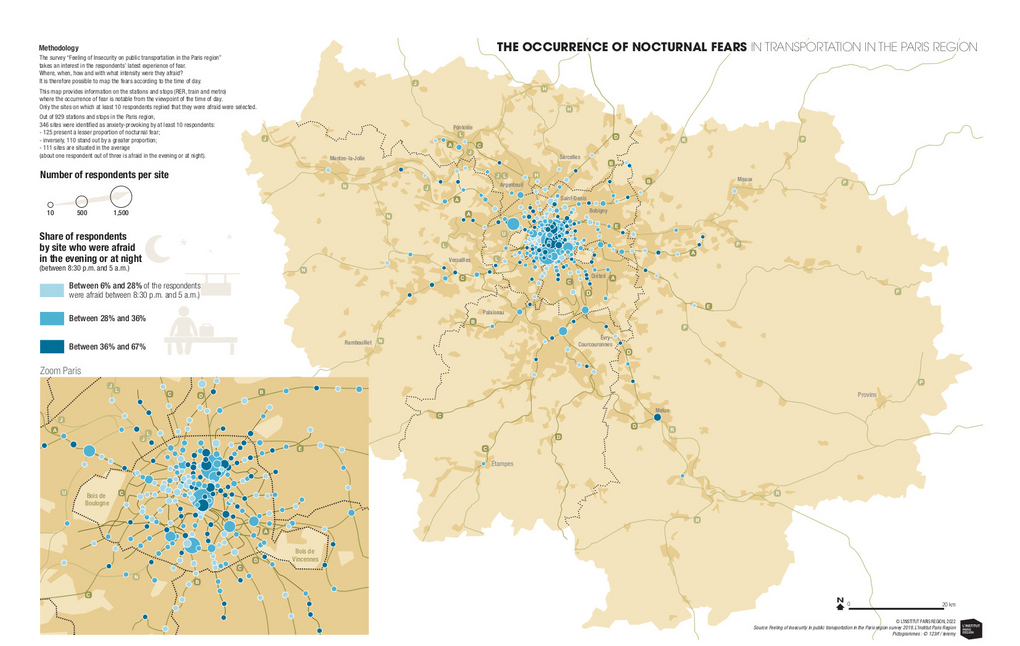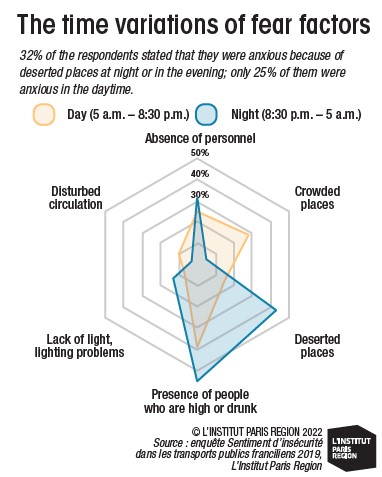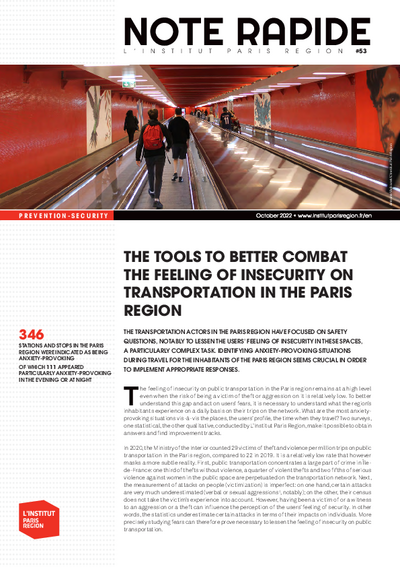The tools to better combat the feeling of insecurity on transportation in the Paris region
The transportation actors in the Paris region have focused on safety questions, notably to lessen the users' feeling of insecurity in these spaces, a particularly complex task. Identifying anxiety-provoking situations during travel for the inhabitants of the Paris region seems crucial in order to implement appropriate responses.
The feeling of insecurity on public transportation in the Paris region remains at a high level even when the risk of being a victim of theft or aggression on it is relatively low. To better understand this gap and act on users’ fears, it is necessary to understand what the region’s inhabitants experience on a daily basis on their trips on the network. What are the most anxiety-provoking situations vis-à-vis the places, the users’ profile, the time when they travel? Two surveys, one statistical, the other qualitative, conducted by L’Institut Paris Region, make it possible to obtain answers and find improvement tracks.
In 2020, the Ministry of the Interior counted 29 victims of theft and violence per million trips on public transportation in the Paris region, compared to 22 in 2019. It is a relatively low rate that however masks a more subtle reality. First, public transportation concentrates a large part of crime in Ile-de- France: one third of thefts without violence, a quarter of violent thefts and two fifths of serious violence against women in the public space are perpetuated on the transportation network. Next, the measurement of attacks on people (victimization) is imperfect: on one hand, certain attacks are very much underestimated (verbal or sexual aggressions, notably); on the other, their census does not take the victim’s experience into account. However, having been a victim of or a witness to an aggression or a theft can influence the perception of the users’ feeling of security. In other words, the statistics underestimate certain attacks in terms of their impacts on individuals. More precisely studying fears can therefore prove necessary to lessen the feeling of insecurity on public transportation.
Île-de-France Mobilités (IDFM), the National Observatory on Crime on Transportation (ONDT) and L’Institut Paris Region consequently conducted in 2019 a new statistical survey, “Feeling of insecurity on transportation in the Paris region” (ESIT-IDF). It reveals similarities between the profiles of victims recorded by the transportation police departments and those of the respondents to the ESIT-IDF who felt afraid in these spaces. Theft with or without violence, for example, the attack the most feared by these respondents as the one most experienced by the victims who were included in the census on transportation. Moreover, these results demonstrate a breakdown by sex of the apprehensions, which more or less corresponds to a division by sex of the victims: those who were victims of or worried about a sexual aggression are in large majority women, while those who were victims or worried about a physical aggression without theft were mostly men. The unequal division of apprehensions responds to an unequal division of victimization.
In the extension of this survey, L’Institut Paris Region carried out a study to provide a territorial anchoring for the quantitative data collected (observations and semi-directive interviews). This study identified the main levers of the battle against the feeling of insecurity in public transportation: the operators and their partners humanize the networks (increasing the number or coordination of the personnel in contact with users); they are also developing a technical security dimension (maintaining, improving or controlling the spaces by notably using innovative technologies such as the use of artificial intelligence to guide the teams’ action); they can lastly include users in the security continuum (encouraging them to adopt the right reflexes or behaviors). These levers are not compartmentalized but function interactively and comprise the links in a safety production chain on public transportation. Analyzing the feeling of insecurity can, furthermore, help direct the deployment of these tools.
MAPPING INSECURITY
The ESIT-IDF statistical survey makes it possible to locate and define the fears, notably through the precise description of the latest experiences of fear in the surveys. Its territorialized nature makes it possible to map the spaces requiring particular attention from the competent authorities, by detailing, for example, the factors at the origin of the fear or the times of day that arouse the most anxiety. The map below (in French) shows the unequal breakdown of nocturnal fear: it is stronger in the large stations in the center (particularly in the north and east of Paris), but also periodically in certain suburban stations (more in the south of the capital).
Consequently, this type of breakdown makes it possible to build indicators that follow up the feeling of insecurity, an evaluation of the actions, even to establish security diagnostics (on the network level – metro, RER [suburban railroad], bus, etc. of lines or stops). If this is interesting to better grasp the insecurity in the Paris region, its territorial dimension offers an innovative tool for the orientation of security policies on transportation. Connecting the latest experiences of fear at a singular space-time to causes and a type of fear makes it possible to provide adapted responses site by site.
STRENGTHENING THE HUMAN PRESENCE, STRONGLY APPROVED BY PEOPLE PRONE TO A FEELING OF INSECURITY
Over half of the respondents to the ESIT-IDF want to increase the number of SNCF and RATP security agents, and almost the same number of gendarmes and police. 26.3% of the respondents pointed out the absence of personnel during their latest experience of fear on public transportation. Reassuring the users therefore implies humanizing the networks.
Different types of personnel handle this mission. The police squad for the Paris region networks crisscross the metro, RER, bus and tram lines, secure strategic points and help victims in specific premises in train stations. Groups specialized in the legal dimension fight against the phenomena of crimes and misdemeanors on public transportation (purse snatching, graffiti, offenses of a sexual nature, etc.). Gendarmes in the Paris region also ensure a regular and organized presence in stations and transportation vehicles, which means they can intervene outside their usual geographic perimeter. Armed and in uniform, the Railroad Safety agents (SNCF) and the Network Protection and Security Group (RATP) ensure the protection of passengers, personnel and the region’s vehicles, stations and buildings. The extension of their field of expertise positions them as key partners of government agents (control of transportation tickets, searches and palpation, patrols of plainclothes police officers, etc.).
BETTER COORDINATING AGENTS IN THE FIELD AND DEVELOPING PARTNERSHIPS
If the increase in the number of these historic actors in security on transportation is a privileged lever in the fight against insecurity, it nevertheless represents a relatively high cost. Consequently, a better interweaving of the different types of agents in the field allows for a stronger human presence on the network: the creation of “safety” departments at the transporters facilitated the coordination with law enforcement officials (circulation of good practices, training or joint patrols, shared targeted operations, etc.). Moreover, the search for innovative partnerships increases the visibility of the human presence: the Paris region has an agreement with the national gendarmerie and finances the creation of private security agent and mediator positions. Mediators, present on public transportation since the late 1990s, guide passengers, decrease tensions and lessen the feeling of insecurity in users and personnel. In addition, their recruitment gives the operators the possibility of going beyond their mission as transporters: prevention in schools, partnership with communities or law enforcement personnel...
PREVENTING CRIME, FAVORING THE FEELING OF SECURITY
For the managers of public transportation, apart from the humanization of the networks, several technical means make it possible to favor the feeling of security. Initially, crime prevention tried to act on its causes (social prevention: education, professional insertion, sports, culture, etc.). As the impact of these methods remains difficult to evaluate, the transporters and their partners turned more toward immediate and customized solutions (situational prevention: light and ambience, individual seating on the platform, video surveillance cameras).
To prevent insecurity on public transportation through the improvement and renovation of the space, three observations must be made. The intensity of the traffic constantly renews the users, who turn out to be ideal targets all the more so if they do not seem used to taking public transportation. The utilitarian and transitory nature of the places does not favor the feeling of belonging or the appropriation of the spaces. The extended character of the network makes surveillance complicated. Therefore, the question is especially one of asserting the presence of a “master of the premises”, using the expression established by the theories on situational prevention. To do so, it appears necessary to regulate the flows, with clear circulation directions, efficient signs and spacious vehicles that are adapted to the traffic, in particular.
The network must also be divided into zones: as the stations are open to the public, the validation of tickets marks the entrance into a space under the responsibility of an identified manager. Maintaining the places is also essential – cleanness takes part in the feeling of security and encourages people to better respect the vehicles and buildings – in the same way as facilitating views, by playing on light or reducing congestion and/or clearing the space, to permit users to see so that they can anticipate being seen in order to be helped.
THINKING ABOUT SECURITY ON A NETWORK
This also concerns thinking about security on a network, following three tracks. First, the need for video surveillance: this facilitates the coordination of the actors in the field in an extended universe. The recent creation of an operational coordination security center (CCOS) at the Paris prefecture of police aims at improving the speed and efficacy of treating safety events. The CCOS provides a panoptic vision to security supervisors (seeing everything without being seen), which does not mask the importance of the placement and renewal of the cameras (seeing better). Second, the call for civility: the transporters empower the users in their communication campaigns to prevent incivilities, which generate a feeling of insecurity. They develop a fraud-incivility diptych (limiting the former would serve the battle against the latter). The call for civility must nonetheless be addressed at all types of users, at the risk of entering an unfruitful exclusion logic (the “good” ones against the “bad” ones). Lastly, the development of stations that provide services that are lively: the managers are present and are involved in the passenger buildings according to the situational prevention principle (natural surveillance, well-being and a feeling of belonging).
The presence of squatters generates anxiety, so spaces must be developed that are both attractive and dissuasive. The RATP and the SNCF are also trying to take in charge people in a social exclusion situation, through societal referents or partnerships with associations.
ASSOCIATING USERS WITH PRODUCING A FEELING OF SECURITY
Travelers are very often the first to intervene when a disturbance appears. The transporters therefore encourage them to pass along the information, notably by providing terminals on the platforms or by communicating the cellphone number and application for an emergency call. It is also a question of including the users or their representatives in the construction of security policies: better knowing one’s customers to target aspirations and needs or, more simply, to evaluate the actions carried out on the local level (measuring the impact of a renovation operation, for example). The operators call on social science to reassure the travelers. For example, the use of the nudge, a technique used in behavior science to encourage individuals to adopt the behavior sought (suggesting rather than constraining). Moreover, the managers can play on the behavioral codes that the individuals have acquired through past experiences. The mobilization of art in the improvement, renovation or animation of spaces makes it possible to provide a feeling of well-being like influencing the behaviors of the largest number of people (respect for the works). The marketing of mobility spaces contributes to increasing the natural surveillance of spaces and imports the proscriptions and prescriptions from the socialization found in shopping (respect for the work of the personnel and other customers). It is therefore a question of thinking of and activating “tendencies to act” acquired earlier, to make behaviors correspond to events (temporary exhibitions) or to types of places (art galleries, stores, restaurants, etc.).
GRASPING THE INFLUENCE OF THE SPACE ON FEAR
The historic actors of security on transportation and the new partners are humanizing the networks. They would acquire more visibility with a still more intertwined coordination, a better involvement of municipal police forces or greater flexibility in the movement of mediators and reservists in the stations. The Paris region’s policy on the technical securing of spaces through large-scale renovation operations changes the experience of public transportation. Most of the buildings are thought of for mass transit and as living spaces, in order to inspire the users’ trust and encourage then to respect these spaces. The transporters encourage the users’ vigilance. They carry out awareness campaigns under the leadership of the authority that organizes mobility.
To accompany and evaluate these systems, the construction of a barometer collecting opinions, victimization and the feeling of insecurity with precision appears to be a necessity. The mapping of fears in the evening and their causes provides assistance to decision-making: what levers can be activated in what places and at what times to reassure worried users? To reduce insecurity on transportation, it is necessary to better understand the motivations behind personal insecurity on transportation in general, but also to grasp the influence of the space on fear, by detailing the feeling of users down to the micro-local scale of a station platform.■
This study is linked to the following theme :
Mobility


